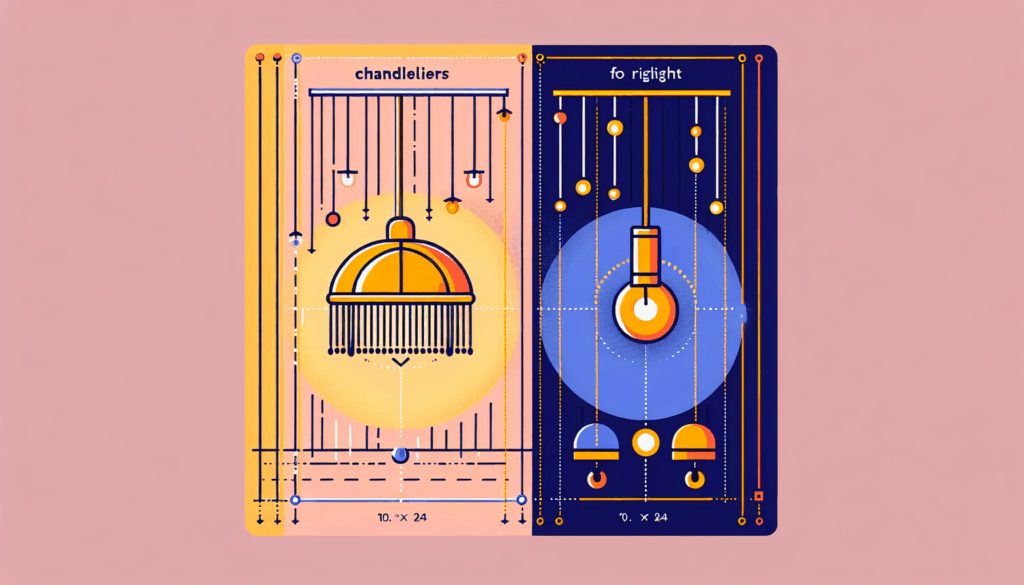When it comes to illuminating our homes, the choice of lighting fixtures can dramatically affect the ambiance, style, and functionality of a space. Among the various options available, chandeliers and pendant lights are two popular choices that often leave homeowners pondering which is right for their needs. Both types of lighting come with unique characteristics, advantages, and aesthetic appeal. In this blog post, we’ll explore the differences between chandeliers and pendant lights, their ideal applications, and how to choose the right one for your space.

Understanding Chandeliers
Chandeliers are often viewed as the epitome of elegance and sophistication. Traditionally, these ornate fixtures are suspended from the ceiling, featuring multiple arms that hold light bulbs and decorative elements such as crystals, glass, or metal. They come in various styles, from classic and vintage to modern and minimalist.
Pros of Chandeliers
1. Visual Impact: Chandeliers are statement pieces that can serve as the focal point of any room, drawing attention and admiration.
2. Variety of Styles: With a wide range of designs available, chandeliers can complement different interior aesthetics, be it traditional, contemporary, or even industrial.
3. Ambient Lighting: They often provide ample ambient lighting, making them suitable for larger spaces such as dining rooms, entryways, and ballrooms.
Cons of Chandeliers
1. Space Requirements: Chandeliers typically require more vertical space than other lighting fixtures, making them less suitable for rooms with low ceilings.
2. Installation Complexity: Installing a chandelier can be more complex and may require professional assistance, especially for larger designs.
3. Maintenance: Depending on the design, chandeliers can accumulate dust and require regular cleaning, particularly those with intricate details.
Exploring Pendant Lights
Pendant lights, on the other hand, are versatile and functional fixtures that can come in a variety of shapes, sizes, and styles. They are usually suspended from the ceiling by a cord, chain, or rod and can be used individually or in groups to create a cohesive lighting design.
Pros of Pendant Lights
1. Versatility: Pendant lights can be used in various settings, from kitchens to living rooms, providing task lighting or accent lighting as needed.
2. Space Efficiency: They are suitable for spaces with lower ceilings and can be installed at varying heights to create visual interest.
3. Customization: With countless designs available, pendant lights can be tailored to fit your personal style, whether you prefer sleek modern designs or rustic looks.
Cons of Pendant Lights
1. Limited Coverage: While they provide focused lighting, a single pendant may not illuminate an entire room adequately, especially larger spaces.
2. Grouping Needed for Impact: To create a similar visual impact as a chandelier, multiple pendant lights may be needed, which can require additional installation and design planning.
3. Height Considerations: If installed too low, pendant lights can obstruct movement, especially in high-traffic areas.
Choosing the Right Fixture for Your Space
When deciding between chandeliers and pendant lights, consider the following factors:
1. Room Size: Evaluate the size of the room you wish to illuminate. Chandeliers are ideal for larger spaces, while pendant lights can work well in smaller areas or as supplementary lighting in larger rooms.
2. Ceiling Height: Measure your ceiling height before making a decision. Chandeliers typically require higher ceilings for proper installation, while pendant lights can be adjusted for lower ceilings.
3. Purpose of Lighting: Determine the primary function of the lighting—whether it’s for ambient lighting, task lighting, or decorative purposes. Chandeliers are excellent for creating ambiance, while pendant lights can provide targeted illumination.
4. Style and Aesthetic: Consider the existing decor and style of your home. Chandeliers can add a touch of luxury, while pendant lights can offer a more casual, contemporary feel. Choose a fixture that complements your overall design scheme.
5. Installation and Maintenance: Think about the practicality of installation and upkeep. If you prefer a low-maintenance option, pendant lights may be easier to manage, especially in terms of cleaning and installation.
Conclusion
Both chandeliers and pendant lights have their unique advantages, and the best choice ultimately depends on your specific needs, preferences, and the characteristics of your home. Chandeliers can make a grand statement and add elegance to your space, while pendant lights offer versatility and functionality. By assessing the size, style, purpose, and installation considerations, you can confidently choose the lighting fixture that enhances your home’s beauty and meets your practical lighting needs. Whatever you choose, both chandeliers and pendant lights have the potential to transform your living space and create the perfect atmosphere for any occasion.
AI-Assisted Content Disclaimer
This article was created with AI assistance and reviewed by a human for accuracy and clarity.






Leave a Reply